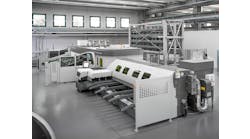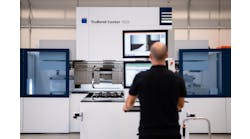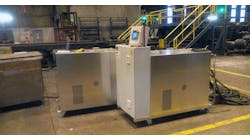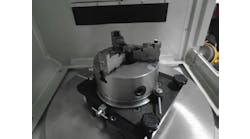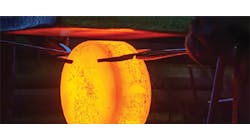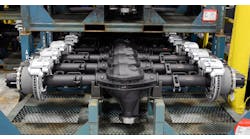A new manufacturing process developed by the Singapore Institute of Manufacturing Technology (SIMTech)—Liquid Forging—reportedly makes it possible to manufacture “intricate and structurally superior” products than are possible with processes like die casting and extrusion. This new process involves creating a liquid melt with wrought aluminum alloys, which is then easy to form into a range of products that demonstrate a) better structural integrity; b) higher aspect ratio; and c) more efficient use of raw materials.
SIMTech reports that its Liquid Forging process helps deliver a cost-effective, efficient way to process high-quality aluminum alloy products. Currently, many products are produced using a mixture of manufacturing processes. A product with intricate design features might be first created using diecasting or extrusion, followed by machining, to remove excess metal and to define its final shape.
However, producing aluminum alloy parts in multiple stages (with substantial secondary processing) can be expensive. For example, in diecasting, a lot of materials are often wasted with the usage of gating and runners as part of its mold design.
Manufacturers rely too much on existing processes to produce aluminum alloy parts, according to SIMTech. In particular, certain limitations of diecasting and extrusion contribute to escalating costs, lower-quality products, and a lack of differentiation in parts design.
These include:
- Material wastage in gating and runners in diecasting
- Porosity in the microstructure of diecast parts
- Surface cracking from high-temperature or highspeed extrusion
- Inability to create three-dimensional extrusion products
- Low aspect ratio (<30:1) from existing metal-forming processes
- Extensive machining is required for certain intricate parts
- Higher press tonnage is required for cold forging
Liquid Forging allows complex geometries to be produced with pore-free parts that minimize material waste. This process uses a pre-determined volume of molten metal that is poured into a die cavity and squeezed under pressure during solidification. This forms aluminum alloy parts in a single operation.
The process produces parts that are able to achieve optimal performance with less material (e.g. lighter heat sinks), resulting in substantial material savings. It also requires minimal machining for cost-effective manufacturing. Moreover, it's a “green” process that increases the recycling of aluminum alloys into new products.
Four Steps to Liquid Forging
Liquid Forging was developed to address porosity issues in die casting, two-dimensional limitations of extrusion, and other challenges of current manufacturing processes.
According to SIMTech, the new process can be scaled for high-output industrial production. It's comprised of four steps:
- Step 1: Aluminum alloy billets are heated in a furnace to 1,256°F (680°C) to create a molten melt that is poured into a preheated die.
- Step 2: A custom-fitted mold closes with direct pressure to create the near-perfect shape of the final product.
- Step 3: The die mold and punch are held together until the shape of the final product is fully formed.
- Step 4: Once the product is cooled, the punch is lifted and the final product is ejected from the mold.
The Switch to Liquid Forging
Liquid Forging offers more flexibility in design for a broad range of shapes and components than any other manufacturing technique, the developers assert. Product designs can be enhanced by using aluminum to manufacture parts that other conventional manufacturing processes are unable to achieve. It’s capable of achieving high aspect ratio features up to 40:1 with a draft angle as low as 0.5 degrees (impossible with die casting, according to SIMTech.)
Internal features such as ribs and variable wall thicknesses for electronic casings also can be formed. Aluminum alloys also allow the production of parts with better strength and thermal conductivity than other materials can achieve.
In die casting, wrought aluminum alloys exhibit poor die-filling characteristics and hot tearing tendencies when melted. Liquid Forging makes it possible to use wrought aluminum alloy in a liquid state to form complex parts with intricate features. High direct melt pressure helps eliminate hot tearing and creates products with superior mechanical properties and features.
Wrought aluminum alloy billets represent a lower raw material cost than extrusion billet or sheet material used in many forming processes. It's also a choice material in terms of thermal conductivity and mechanical strength.
The mold design identified for liquid forging is flexible, with interchangeable inserts that make it possible to create products in a single stage rather than joining via multiple steps and individual parts (e.g., solders, rivets, and screws), thus improving strength and thermal performance.
In addition, liquid forging products are heat treatable, to allow further improvements in mechanical properties, and they can be anodized to achieve more aesthetic appeal and better performance.
Liquid Forging products achieve greater tensile strength with zero porosity because direct high pressure on the melt prevents trapped air bubbles, improving the strength and thermal performance of final products. And, a shorter cooling and solidification time creates finer-grained metal structures with better mechanical properties.
Applications for Liquid Forging
SIMTech states that adopting a flexible design process will allow manufacturers to create products of various shapes and sizes for the automotive, aerospace, precision engineering, biomedical, and electronic industries. A primary example is heat sinks for LED lighting, which require high aspect ratios in order to maintain the necessary cooling function. It’s also possible to form a heat sink with the light fixture in a single process, according to SIMTech.
Other aluminum alloy parts can be manufactured efficiently with minimal wasted raw material.


